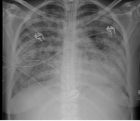Abstract
Case Report
Eosinophilic otitis media and eosinophilic asthma: Shared pathophysiology and response to anti-IL5
Marieke T Drijver-Messelink*, Mariette Wagenaar, Jacqueline van der Meij and Anneke ten Brinke
Published: 04 June, 2019 | Volume 3 - Issue 1 | Pages: 009-012
Asthma is a highly prevalent airway disease with multiple phenotypes [1,2]. Adult-onset eosinophilic asthma is a severe asthma subtype associated with more frequent and severe exacerbations, the development of persistent airflow limitation and a poorer quality of life. This type of asthma is much more difficult to control than other asthma subtypes, requiring high doses of inhaled or even oral corticosteroids (OCS) [3,4]. Recently, several new monoclonal antibody therapies have been approved for eosinophilic severe asthma, including anti-IL-5 treatment. IL-5 is essential for eosinophilic maturation and survival [5] and anti-IL5 treatment has markedly reduced asthma exacerbations with sparing of OCS use in patients with eosinophilic asthma [6]. Eosinophilic asthma is frequently associated with chronic rhinosinusitis and/or nasal polyposis [7], suggesting that a similar eosinophilic inflammatory process might drive both conditions. Eosinophilic otitis media (EOM) also might fit in this concept, showing remarkable similarities with asthma and nasal polyposis. The disease was first reported in 1994, but only since 2011 diagnostic criteria for EOM were identified. If a patient shows otitis media with effusion or chronic otitis media with eosinophil-dominant effusion (major criterion) and is being positive for ≥2 items of the 4 minor criteria (highly viscous middle ear effusion, resistance to conventional treatment, association with asthma, association with nasal polyposis) he is diagnosed as having EOM. Eosinophilic granulomatosis with polyangiitis and hypereosinophilic syndrome must be excluded [8].
Read Full Article HTML DOI: 10.29328/journal.jprr.1001011 Cite this Article Read Full Article PDF
References
- Wenzel SE. Asthma: defining of the persistent adult phenotypes. Lancet. 2006; 368(9537): 804-813. Ref.: https://bit.ly/2WAWGAQ
- Anderson GP. Endotyping asthma: new insights into key pathogenic mechanisms in a complex, heterogeneous disease.2008; 372(9643): 1107-1119. Ref.: https://bit.ly/2QCRxTe
- de Groot JC, Ten Brinke A, Bel EH. Management of the patient with eosinophilic asthma: a new era begins. ERJ Open Res. 2015; 1. Ref.: https://bit.ly/2Mqurkg
- de Groot JC, Storm H, Amelink M, de Nijs SB, Eichhorn E, et al. Clinical profile of patients with adult-onset eosinophilic asthma. ERJ Open Res. 2016; 2: 00100-2015. Ref.: https://bit.ly/2KnQohx
- Russell R, Brightling CE. Anti-IL-5 for Severe Asthma: Aiming High to Achieve Success. Chest. 2016; 150: 766-768. Ref.: https://bit.ly/2XmSWQD
- Bel EH, ten Brinke A. New Anti-Eosinophil Drugs for Asthma and COPD. Targeting the trait! Chest. 2017; 152: 1276-1282. Ref.: https://bit.ly/2Wqtnlm
- van der Meer AN, ten Brinke A. Nasal polyposis and asthma: the chest physician’s view. In: Bachert C, Bourdin A, Chanez P, eds. The Nose and Sinuses in Respiratory Disorders (ERS Monograph). Sheffield, European Respiratory Society. 2017; 105–121. Ref.: https://bit.ly/2WlP4ms
- Iino Y, Tomioka-Matsutani S, Matsubara A, Nakagawa T, Nonaka M. Diagnostic criteria of eosinophilic otitis media, a newly recognized middle ear disease. Auris Nasus Larynx. 2011; 38: 456-461. Ref.: https://bit.ly/2If8QGp
- Ueki S, Ohta N, Takeda M, Konno Y, Hirokawa M. Eosinophilic Otitis Media: the Aftermath of Eosinophil Extracellular Trap Cell Death. Curr Allergy Asthma Rep. 2017; 17:33. Ref.: https://bit.ly/2QHSARQ
Figures:

Figure 1
Similar Articles
-
Avoiding confusion in high flow oxygen therapy conceptsGarcía G,Valencia P,Mercedes E, Sarhane Y,Díaz-Lobato S*,Agosta M. Avoiding confusion in high flow oxygen therapy concepts. . 2017 doi: 10.29328/journal.jprr.1001001; 1: 001-002
-
Acute and chronic changes in massive Barium Sulfate aspiration in an infant who subsequently was diagnosed with severe Gastro-esophageal RefluxSevgi Pekcan*. Acute and chronic changes in massive Barium Sulfate aspiration in an infant who subsequently was diagnosed with severe Gastro-esophageal Reflux . . 2017 doi: 10.29328/journal.jprr.1001002; 1: 003-008
-
Successful Therapy with intravenous gamma globulin in two children with postinfectious bronchiolitis obliteransSevgi Pekcan,Bahar Gökturk*, Ismail Reisli. Successful Therapy with intravenous gamma globulin in two children with postinfectious bronchiolitis obliterans. . 2017 doi: 10.29328/journal.jprr.1001003; 1: 009-012
-
Fluticasone furoate/Vilanterol 92/22 μg once-a-day vs Beclomethasone dipropionate/Formoterol 100/6 μg b.i.d. in asthma patients: a 12-week pilot studyClaudio Terzano*,Francesca Oriolo. Fluticasone furoate/Vilanterol 92/22 μg once-a-day vs Beclomethasone dipropionate/Formoterol 100/6 μg b.i.d. in asthma patients: a 12-week pilot study . . 2017 doi: 10.29328/journal.jprr.1001004; 1: 013-022
-
A decade of targeted therapy for non-small cell lung cancerKhalid Abu Ajaj*. A decade of targeted therapy for non-small cell lung cancer. . 2017 doi: 10.29328/journal.jprr.1001005; 1: 023-027
-
Successful treatment of late-onset pulmonary hypertension after atrial septal defect operation with macitentan: Our center experienceTarik Kivrak*,Zeynep Ulutas,Sena Sert, Bulent Mutlu. Successful treatment of late-onset pulmonary hypertension after atrial septal defect operation with macitentan: Our center experience . . 2018 doi: 10.29328/journal.jprr.1001006; 2: 001-003
-
Effect of diabetes mellitus on the Pulmonary Function Tests in Sudanese Diabetic PatientsElmutaz H Taha,Ibrahim A Ali*,Omer A Musa. Effect of diabetes mellitus on the Pulmonary Function Tests in Sudanese Diabetic Patients . . 2018 doi: 10.29328/journal.jprr.1001007; 2: 004-010
-
COPD and low plasma vitamin D levels: Correlation or causality?Luca Gallelli*, Erika Cione,Stefania Zampogna, Gino Scalone. COPD and low plasma vitamin D levels: Correlation or causality? . . 2018 doi: 10.29328/journal.jprr.1001008; 2: 011-012
-
Peculiarities of photon emisson of whole non-diluted human blood obtained from healthy donors and patients with some diseasesKirill N Novikov*,Vladimir L Voeikov,Ekaterina V Buravleva,Nadezhda G Berdnikova. Peculiarities of photon emisson of whole non-diluted human blood obtained from healthy donors and patients with some diseases . . 2018 doi: 10.29328/journal.jprr.1001009; 2: 013-019
-
Stethoscope - Over 200 yearsHenrik Permin*,Svend Norn . Stethoscope - Over 200 years . . 2019 doi: 10.29328/journal.jprr.1001010; 3: 001-008
Recently Viewed
-
Needs in siblings of individuals with Down Syndrome and levels of coping Cali, ColombiaLina Fernanda Martínez Cadavid,Diana Marcela Gutiérrez Acosta,Luis Alexander Lovera Montilla*. Needs in siblings of individuals with Down Syndrome and levels of coping Cali, Colombia. J Adv Pediatr Child Health. 2021: doi: 10.29328/journal.japch.1001041; 4: 093-100
-
Non-surgical Treatment of Verrucous Hyperplasia on Amputation Stump: A Case Report and Literature ReviewSajeda Alnabelsi*, Reem Hasan, Hussein Abdallah, Suzan Qattini. Non-surgical Treatment of Verrucous Hyperplasia on Amputation Stump: A Case Report and Literature Review. Ann Dermatol Res. 2024: doi: 10.29328/journal.adr.1001034; 8: 015-017
-
Investigating Anti-Bacterial and Anti-COVID-19 Virus Properties and Mode of Action of Pure Mg(OH)2 and Copper-infused Mg(OH)2 Nanoparticles and Coated Polypropylene SurfacesSaleh Alkarri*, Melinda Frame, John Cairney, Lee Maddan, Jin H Kim, Jonathan O Rayner. Investigating Anti-Bacterial and Anti-COVID-19 Virus Properties and Mode of Action of Pure Mg(OH)2 and Copper-infused Mg(OH)2 Nanoparticles and Coated Polypropylene Surfaces. Int J Clin Virol. 2024: doi: 10.29328/journal.ijcv.1001057; 8: 008-023
-
A Low-cost High-throughput Targeted Sequencing for the Accurate Detection of Respiratory Tract PathogenChangyan Ju, Chengbosen Zhou, Zhezhi Deng, Jingwei Gao, Weizhao Jiang, Hanbing Zeng, Haiwei Huang, Yongxiang Duan, David X Deng*. A Low-cost High-throughput Targeted Sequencing for the Accurate Detection of Respiratory Tract Pathogen. Int J Clin Virol. 2024: doi: 10.29328/journal.ijcv.1001056; 8: 001-007
-
About Efficiency of High-order Harmonic Generation in Attosecond PhysicsAng-Yang Yu*. About Efficiency of High-order Harmonic Generation in Attosecond Physics. Int J Clin Virol. 2024: doi: 10.29328/journal.ijcv.1001061; 8: 045-047
Most Viewed
-
Evaluation of Biostimulants Based on Recovered Protein Hydrolysates from Animal By-products as Plant Growth EnhancersH Pérez-Aguilar*, M Lacruz-Asaro, F Arán-Ais. Evaluation of Biostimulants Based on Recovered Protein Hydrolysates from Animal By-products as Plant Growth Enhancers. J Plant Sci Phytopathol. 2023 doi: 10.29328/journal.jpsp.1001104; 7: 042-047
-
Sinonasal Myxoma Extending into the Orbit in a 4-Year Old: A Case PresentationJulian A Purrinos*, Ramzi Younis. Sinonasal Myxoma Extending into the Orbit in a 4-Year Old: A Case Presentation. Arch Case Rep. 2024 doi: 10.29328/journal.acr.1001099; 8: 075-077
-
Feasibility study of magnetic sensing for detecting single-neuron action potentialsDenis Tonini,Kai Wu,Renata Saha,Jian-Ping Wang*. Feasibility study of magnetic sensing for detecting single-neuron action potentials. Ann Biomed Sci Eng. 2022 doi: 10.29328/journal.abse.1001018; 6: 019-029
-
Pediatric Dysgerminoma: Unveiling a Rare Ovarian TumorFaten Limaiem*, Khalil Saffar, Ahmed Halouani. Pediatric Dysgerminoma: Unveiling a Rare Ovarian Tumor. Arch Case Rep. 2024 doi: 10.29328/journal.acr.1001087; 8: 010-013
-
Physical activity can change the physiological and psychological circumstances during COVID-19 pandemic: A narrative reviewKhashayar Maroufi*. Physical activity can change the physiological and psychological circumstances during COVID-19 pandemic: A narrative review. J Sports Med Ther. 2021 doi: 10.29328/journal.jsmt.1001051; 6: 001-007

HSPI: We're glad you're here. Please click "create a new Query" if you are a new visitor to our website and need further information from us.
If you are already a member of our network and need to keep track of any developments regarding a question you have already submitted, click "take me to my Query."



















































































































































